To:
Describe the appearance of various organs found in the frog.
• Name locate and identify the organs that make up various systems of the frog.
• Compare and contrast frog anatomy to our past dissections.
• Contrast and compare various frog's organs to human.
Background information:
Frogs are classified as amphibians "live a double life". Frogs are part of the amphibian order, Anura. Tadpoles are aquatic and herbivores. Adult frogs can live on land and in water and are carnivores. Strong muscles and special fused bones help frogs be powerful swimmers and jumpers. Frogs have loose, mucous lined skin to help them escape from predators, and keep them wet which aides in cutaneous respiration (breathing through the skin). Tadpoles breath through gills. Frogs breath though underdeveloped lungs and their skin. Cutaneous respiration limits the frogs body size. The backs of frogs are dark, while their undersides are light, to camouflage them on land and water. Frog brains are smaller and less developed than other vertebrates, they also have a 3 chambered heart.
Materials required:
• safety goggles, gloves, and a lab apron
• forceps
• preserved frog
• dissecting pins (6–10)
• dissecting tray and paper towels
• plastic storage bag and twist tie
• scissors
• marking pen
• dissecting needle
Procedure:
1.Put on safety goggles, gloves, and a lab apron.
2.Place a frog on a dissection tray. To determine the frog’s sex, look at the hand digits, or fingers, on its forelegs. A male frog usually has thick pads on its "thumbs," which is one external difference between the sexes, as shown in the diagram below. Male frogs are also usually smaller than female frogs. Observe several frogs to see the difference between males and females.
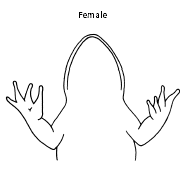
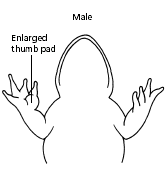
3.Use the diagram below to locate and identify the external features of the head. Find the mouth, external nares, tympani, eyes, and nictitating membranes

Turn the frog on its back and pin down the legs. Cut the hinges of the mouth and open it wide. Use the diagram below to locate and identify the structures inside the mouth. Use a probe to help find each part: the vomerine teeth, the maxillary teeth, the internal nares, the tongue, the openings to the Eustachian tubes, the esophagus, the pharynx, and the slit-like glottis.
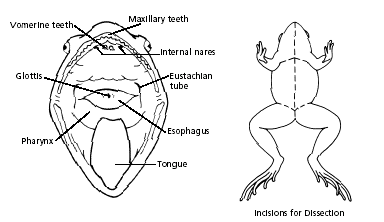
5. Look for the opening to the frog’s cloaca, located between the hind legs. Use forceps to lift the skin and use scissors to cut along the center of the body from the cloaca to the lip. Turn back the skin, cut toward the side at each leg, and pin the skin flat. The diagram above shows how to make these cuts
6. Lift and cut through the muscles and breast bone to open up the body cavity. If your frog is a female, the abdominal cavity may be filled with dark-colored eggs. If so, remove the eggs on one side so you can see the organs underlying them.
7.use the diagram below to locate and identify the organs of the digestive system: esophagus, stomach, small intestine, large intestine, cloaca, liver, gallbladder, and pancreas.
8.Again refer to the diagram below to identify the parts of the circulatory and respiratory systems that are in the chest cavity. Find the left atrium, right atrium, and ventricle of the heart. Find an artery attached to the heart and another artery near the backbone. Find a vein near one of the shoulders. Find the two lungs.
Use a probe and scissors to lift and remove the intestines and liver. Use the diagram on the next page to identify the parts of the urinary and reproductive systems. Remove the peritoneal membrane, which is connective tissue that lies on top of the red kidneys. Observe the yellow fat bodies that are attached to the kidneys. Find the ureters; the urinary bladder; the testes and sperm ducts in the male; and the ovaries, oviducts, and uteri in the female.
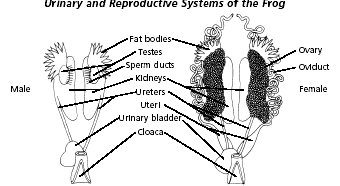
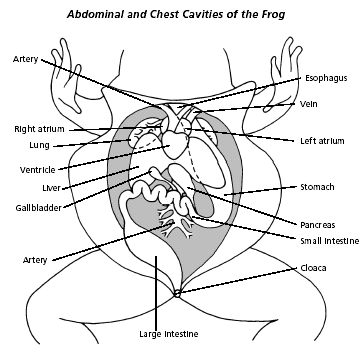
10.
Remove the kidneys and look for threadlike spinal nerves that extend from the spinal cord. Dissect a thigh, and trace one nerve into a leg muscle. Note the size and texture of the leg muscles.
11.
Dispose of your materials according to the directions from your teacher.
12.
Clean up your work area and wash your hands before leaving the lab.
No comments:
Post a Comment